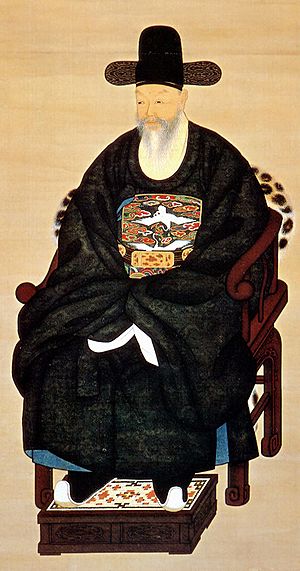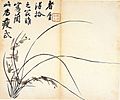Gim Jeong-hui facts for kids
| Gim Jeong-hui | |
 |
|
Quick facts for kids Korean name |
|
|---|---|
| Hangul |
김정희
|
| Hanja |
金正喜
|
| Revised Romanization | Gim Jeonghui |
| McCune–Reischauer | Kim Chǒnghǔi |
Gim Jeong-hui (김정희, 金正喜) was a famous Korean scholar, artist, and writer who lived from 1786 to 1856. He was known for his amazing calligraphy (beautiful handwriting), his study of old inscriptions (epigraphy), and his deep knowledge. He belonged to the Gyeongju Gim family.
Gim Jeong-hui used many different pen-names, like Wandang, Chusa, and Yedang. He is especially famous for changing how people studied old Korean and Chinese writings. He also created his own special writing style called “Chusa-che.” His ink paintings, especially those of orchids, are also very well-known and admired.
As a scholar, he was part of the Silhak school, which focused on "Practical Learning." This group believed in studying things that were useful for society. He was related to important people in the royal family, including Queen Jeongsun and the grandfather of King Gojong. Even Heungseon Daewongun, King Gojong’s father and a famous calligrapher himself, was one of Gim Jeong-hui’s students for a time.
Contents
Gim Jeong-hui's Life Story
Early Years and Family
Gim Jeong-hui was born in 1786 in Yesan, which is now in South Chungcheong Province. He was the oldest son in his family. His family was very important, with many relatives holding high positions in the government. Some of them were also known for their beautiful calligraphy. His great-grandfather had even married a princess, the daughter of King Yeongjo.
People say he was a very talented calligrapher even as a child. When he was only 7 years old, a famous scholar named Chae Je-gong was amazed by a good-luck charm Gim Jeong-hui had written. From the age of 15, he was taught by Pak Je-ga, another well-known scholar who believed in "Northern Learning."
Growing Up and Changes
When Gim Jeong-hui was young, his family faced some tough times. His oldest uncle was sent away from home, and several family members, including his grandparents, died. Because his uncle had no sons, it was decided that Gim Jeong-hui would be adopted by him. This meant Gim Jeong-hui would become the next head of that part of the family.
In 1800, when he was 15, he got married. That same year, King Jeongjo died. The new king was very young, so Queen Jeongsun (the previous king's wife) became the ruler for a while. Gim Jeong-hui's birth father gained a higher position because of his family's connection to the Queen.
Challenges and New Beginnings
More sadness came for Gim Jeong-hui. His birth mother died in 1801. Then, in 1805, Queen Jeongsun died, and just a few weeks later, his young wife passed away too. His teacher, Pak Je-ga, also died that year. These many losses made him more interested in Buddhism, which helped him find comfort and meaning.
After a period of mourning, he married his second wife in 1808. In 1809, he did very well in a special government exam called the Gwageo.
Journey to China
In 1810, Gim Jeong-hui went to China with his birth father, who was a special envoy. He stayed there for about six months. In China, he met famous scholars like Weng Fanggang and Ruan Yuan, who recognized his talent. He studied a lot about history and old documents. Ruan Yuan even gave him a book about calligraphy. Gim Jeong-hui kept in touch with these scholars after he returned to Korea.
When he came back, he didn't immediately take an official job. Instead, he continued to study and write essays that questioned the strict rules of Confucianism. He also traveled to study old stone monuments and their inscriptions. Around 1815, he met a respected Buddhist monk named Cho-ui, and they became very close friends.
Government Work and Exile
Gim Jeong-hui passed another important national exam in 1819. He then held important jobs, like being a secret inspector and a tutor to the Crown Prince. However, after the prince died, a powerful family called the Andong Gim clan gained control. Gim Jeong-hui lost his high position, and his adoptive father was sent away from home for several years.
Things improved in 1835 when King Heonjong became king. Gim Jeong-hui rose to a high government rank. That same year, he visited his friend, the monk Cho-ui, at Daeheung-sa temple.
After King Sunjo of Joseon died in 1834, his wife, Queen Sunwon (from the Andong Gim clan), became very powerful because her grandson, King Heonjong, was still a child. There was a lot of political fighting, and in 1840, Gim Jeong-hui was sent into exile on Jeju Island. His wife died in 1842 while he was still in exile.
It was during these years on Jeju Island that he created his famous "Chusa style" of calligraphy. This style was based on his studies of ancient Korean and Chinese writings. His friend, the monk Cho-ui, visited him many times on Jeju Island, bringing him gifts of tea and helping him.
In 1844, while in exile, Gim Jeong-hui created his most famous ink painting, called “Sehando” (meaning ‘Winter Scene’). He gave this painting to his student Yi Sang-jeok to thank him for his friendship and for bringing him valuable books from China. The painting shows a simple house and two old pine trees. Many scholars, both Chinese and Korean, added their own writings and poems to the painting, making it a unique work of art.
After King Heonjong died in 1849, there were disagreements about moving his tomb. Gim Jeong-hui's friend was involved, and because of this, Gim Jeong-hui was sent into exile again, this time to Bukcheong in northern Korea, from 1850 to 1852.
Later Life and Legacy
After his second exile, Gim Jeong-hui settled in Gwacheon, a town south of Seoul, where his birth father was buried. He lived in a house he called Gwaji Chodang. In 1856, he spent some time at Bongeun-sa temple in what is now Seoul’s Gangnam area, and it is said he became a monk there. Later that year, he returned home to Gwacheon and continued to write until the day before he died.
After his death, his students collected and published his letters, poems, and other writings. These books helped keep his ideas and art alive for future generations.
What Gim Jeong-hui Achieved
Gim Jeong-hui had a huge impact on Korean scholars in the late 1800s. People said he taught 3,000 students! He was seen as a leader who wanted to modernize Korea, and his ideas helped lead to the Enlightenment Party later on. Many important scholars of his time were connected to him.
His main interests were studying history through old documents and inscriptions on monuments. He even talked about these topics with major scholars in China. He is especially famous for figuring out and identifying a stone monument on Mount Bukhan that honored a visit by King Jinheung of Silla (an ancient Korean kingdom).
Gim Jeong-hui is remembered for his amazing skills in calligraphy, ink painting, and his writings. He often created a new pen-name for himself whenever he painted orchids for a friend, which is why he had so many different names!
His Connection to Buddhism
It seems Gim Jeong-hui visited Buddhist temples from a young age. When several people close to him died around 1805, he became even more interested in Buddhist practices. Many of his calligraphic works are copies of Buddhist texts, and he wrote name boards for halls in temples like Daeheung-sa and Bongeun-sa.
Scholars who followed the "Practical Learning" tradition, like Gim Jeong-hui, often showed interest in either Catholicism or Buddhism. This was partly because they were reacting against the very strict and worldly Confucianism of their time.
He was particularly close to the Buddhist monks Cho-ui Seonsa and Baekpa Daesa. In 1815, Cho-ui came to Seoul and became good friends with many highly educated scholars and government officials, including Gim Jeong-hui and his brothers. This was quite unusual because Buddhist monks were generally given a low rank in society. Cho-ui was not even allowed inside the city walls of Seoul, so he met his scholar friends outside the capital.
Gim Jeong-hui once had a disagreement with another famous monk, Baekpa Geungseon, about some Buddhist ideas. Gim Jeong-hui believed that the true meaning of Seon (a type of Buddhism) should be simple and natural, not complicated by human ideas. However, when Baekpa died in 1852, Gim Jeong-hui still wrote a respectful epitaph (a writing on a tombstone) for him.
Gallery
See also
 In Spanish: Kim Jeong-hui para niños
In Spanish: Kim Jeong-hui para niños







